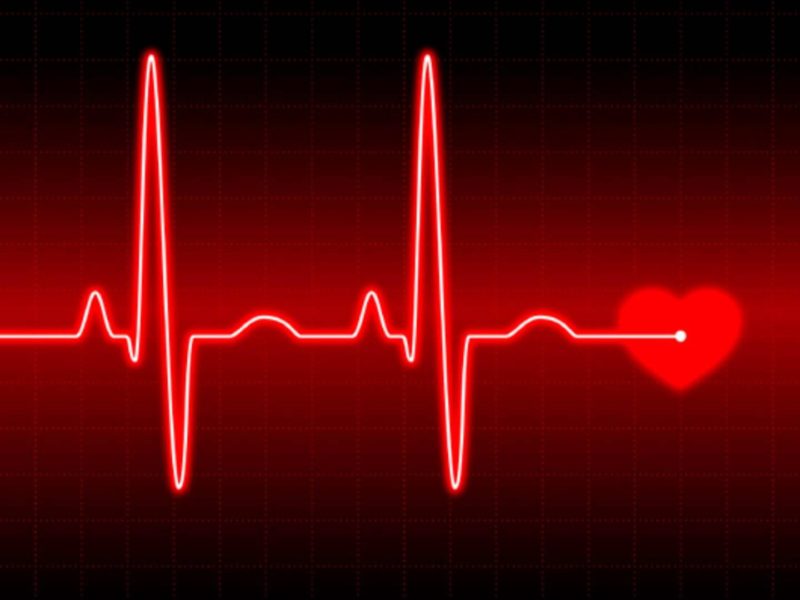Each of us has a unique opportunity to feel the contraction of the heart muscle by the pulsation of the vein, only by touching the wrist in the place where the vein is closest to the surface of the skin. To control health, it is worth knowing what a healthy pulse is, the norm by age in women. Violation of the norm indicates the presence of some diseases that affect the heart.
An interesting fact: the normative pulse for women and the stronger sex is not the same: if for a man the average rate is 60-70 beats per minute, then for women - 70-80.
Material Content:
Pulse - the norm by age in women: table
The older the ladies, the faster the pulse, which is not considered a pathology at all.
| Age | Heart rate | Average | Arterial pressure |
|---|---|---|---|
| less than 50 | 60 - 80 | 70 | 116-137/70-85 |
| 50-60 | 65 - 85 | 75 | 140/80 |
| 60-80 | 70 - 90 | 80 | 144-159/85 |
Such indicators are when a woman is in order and peace of mind. But there are special conditions when the pulse changes, which is not considered a violation. Including during pregnancy.
Norm of heart rate during pregnancy
At a special stage in a woman’s life, when she bears a fetus, her entire body changes in order to ensure the comfortable development of the baby in the womb. All the body systems of the expectant mother provide the baby with nutrition, oxygen, and the supply of minerals and vitamins. Mommies sometimes feel the pulse increase, and the heart as if jumping out of the chest. This is a completely normal phenomenon, laid down by nature itself.

From the moment a woman begins life, the amount of blood in the body increases to provide oxygen and nutrients for not just one, but two lives. And the heart also has to work for two.By the second trimester of pregnancy, the fetus has already formed all vital systems, and they require a full supply of everything necessary for life support. The heart pumps the whole volume of blood with a vengeance, the pulse increases to 110-115 beats per minute. Usually in this situation, extremely unpleasant sensations arise and negative changes occur in the body. And during pregnancy, this temporary tachycardia does not cause any harm to either the mother or the child. And after giving birth, the pulse again returns to normal - 60-80 beats per minute. However, some women have latent or overt heart problems. Then tachycardia can be combined with nausea and vomiting. This is an occasion to immediately visit a cardiologist and conduct a diagnosis of the cardiovascular system.
And it happens that mommy has bradycardia. If a decrease in pulsation does not entail a deterioration in the health of the pregnant woman, then this condition does not threaten any harm to her or the baby.
What should be the frequency of beats per minute of a pulse in a healthy adult
A normal pulse in an adult is within the boundaries at which people are in great shape. Ideal is considered to be from 60 to 90 per minute. A frequent pulse is called tachycardia, and if on the contrary it is less than normal, it is bradycardia. The interval between strokes is also taken into account, it should not change. If the intervals between heartbeats vary, this is called arrhythmia. And this is an occasion to think whether everything is in order. The heart pumps blood through the veins and arteries, delivering oxygen and nutrients to each cell. If this work is disrupted, all systems suffer from a shortage of vital resources. And a person feels it right away. Heartbeat is hard to miss. You can check how much the pulse deviated from the norm using the heart rate monitor, which is now complete with tonometers - blood pressure monitors, and even in a special application for an iPhone or smartphone. Take at least instant Heart Rate. All such applications will not only tell you how broken the pulse is, but they will also keep test statistics.

The pulse in a healthy adult cannot always be the same. It changes several times a day.
Normal heart rate at rest
A normal pulse in a calm state is the standard, with which the change in heart rate in various situations is compared.

Normal heart rate is also different for everyone. For example:
- in adolescents, the allowable pulse is 80 beats per minute;
- for the stronger sex - from 60 to 80;
- in women - from 68 to 90;
- in children of the first and second years of life - 100;
- in newborns - 140.
By the way, in the morning a person may be surprised that his pulse is 51 - 55 beats per minute. And this is also quite acceptable. The heart was in a state of complete rest at night.
Running heart rate
Running is a great opportunity to strengthen the tone, muscles of the body, raise immunity, improve mood. The main thing is not to the detriment of health. And one of the indicators is the heart rate. Of course, the pulse increases as the load increases. But if this increase is kept within the norm, then everything is fine. If it exceeds, and even is accompanied by an increase in pressure - it is worth thinking about the correction of training.

There is a simple formula for determining the maximum limit of the increase in heart rate while running. It is enough to subtract the number of full years from 200.
When there is a goal to lose weight, you should give all your best. But when the goal is simply to improve health, then 60% of the maximum permissible limits for increasing heart rate are enough.
When walking
Normal or athletic walking increases the pulse to such limits when the body receives an excellent optimal load for training the heart and blood vessels. The average number of strokes in this case is 100 per minute. This is an ideal indicator.
In untrained people, the pulse may be higher. It is worth comparing:
- in 20-25 years - up to 140 strokes;
- at 40-45 years old - up to 135;
- at 70 years and older - up to 110.
If the number of strokes is higher than the norm, additional loads should be excluded.
Training Heart Rate
Training has a different degree of load, which means that they affect the heartbeat and pulse in different ways.

By the level of impact on the body, training can be divided into:
- small when the heart rate rises to 100-130;
- average level when the pulse is 140-150;
- increased loads when the pulse rises to 170-190.
To accurately calculate the load, and this is always individual, you must initially know your indicators at rest.
Normal heart rate during sleep
When we sleep, the heart is at rest and relaxed. And at this time, the heartbeat slows down as much as possible, it becomes one and a half times lower than the daytime. There is such a phase of sleep when the heart rate reaches a minimum. This is about 3-4 in the morning. Alas, it is in such morning hours that heart attacks most often occur. The reason is the active vagus nerve, which acts on the heart muscle precisely at night. By the way, in the very first minutes after waking up, the frequency of strokes is below average and can be equal to 52-55 beats per minute.
It is important to know that the heart rate in healthy people should be the same on both wrists. When there is a difference, this is direct evidence of circulatory problems and insufficient blood supply to the extremities.
This happens for the following reasons:
- arterial stenosis;
- stenosis of the mouth of the peripheral artery;
- arthritis.
If such a deviation is noticed, you should visit a doctor in the near future.
What pulse is considered normal in women at 30, 40, 50, 60 years old?
With age, the pulse in women changes. There are many reasons for this. These are hormonal changes, and obesity, and bad eating habits, and the presence of chronic diseases.
In the reproductive age of 30-40 years, in women, 65-80 beats per minute are considered a normal pulse. And at the age of 45-50, due to hormonal changes, the pulse can sometimes increase to 100 beats per minute. This occurs during the “ebbs” and “ebbs” in the premenopausal and menopausal periods. By the way, it is at this age that for the first time in some women problems with the heart and blood vessels begin, hypertension can occur.

At 60, the heart should return to normal, and the heart rate should be kept within 65-80 beats per minute. However, if hypertension occurred at this point, there is obesity, chronic diseases of the thyroid gland, kidneys, heart and other health problems, then the heart rate will change in the direction of increase or decrease. Abnormalities in the heart usually lead to a lower heart rate.
Keeping track of your heart rate in various situations is not difficult, but extremely necessary. This is one of the available health tests. And do not neglect this.












